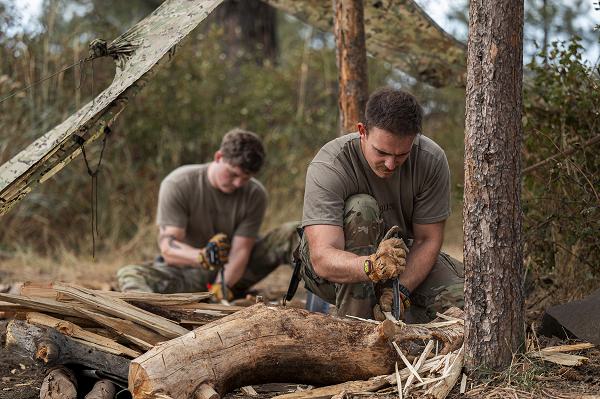
Fairchild Air Force Base, Washington. (October 17, 2024): Since World War II, American air crews have been captured, brutalized, and exploited by our enemies. In this photo by Senior Airman Tiffany Del Oso, Airman 1st Class Joe Trybus and Airman 1st Class Benathan Deman participate in Survival Escape and Evasion (SERE) training conducted by the Air Force’s 66th Training Squadron. In this phase of their training, SERE students are taught techniques to adapt to their surroundings to survive. This is the “evasion” part.
What is expected of an American warfighter if captured? This is the resistance part, and by far the most difficult both physically and emotionally. The need for escape and evasion training has its origins in the number of allied pilots downed over the skies of Germany. The training has been expanded in recent years due to the extreme mistreatment of POWs by our adversaries. During the Korean War, enemy prisoners were beaten and publicly displayed for propaganda purposes. In Vietnam’s infamous Hanoi Hilton prison, GI’s were subject to years of torture, starvation, and degradation.
These acts are war crimes under the Geneva Conventions of 12 August 1949 regarding the treatment of Prisoners of War. The Conventions forbid mistreatment of enemy combatants and civilians physically and mentally and all forms of exploitation. America’s enemies simply ignore international law and justify brutalizing POWs by claiming they were simply outlaws in an "undeclared war."
For these reasons, the military conducts advanced SERE training for individuals at high risk of capture whose position, rank, or seniority make them high value targets. They receive extremely realistic training on resisting exploitation during interrogations and how to survive the harsh conditions they will experience in captivity.
Students are put through a "simulation laboratory" where instructors function as hostile captors and soldier-students as prisoners. The treatment students receive is as realistic as possible compared to what POWs can expect in captivity. Students experience isolation, close confinement, stress, mock interrogation, and torture "simulations".
They are also taught how to conduct themselves while in captivity to never compromise the U.S. mission, their fellow captives, and their own honor. While it is impossible to simulate the reality of hostile captivity, this training has proven very effective in helping those most at risk of capture know what to expect.


